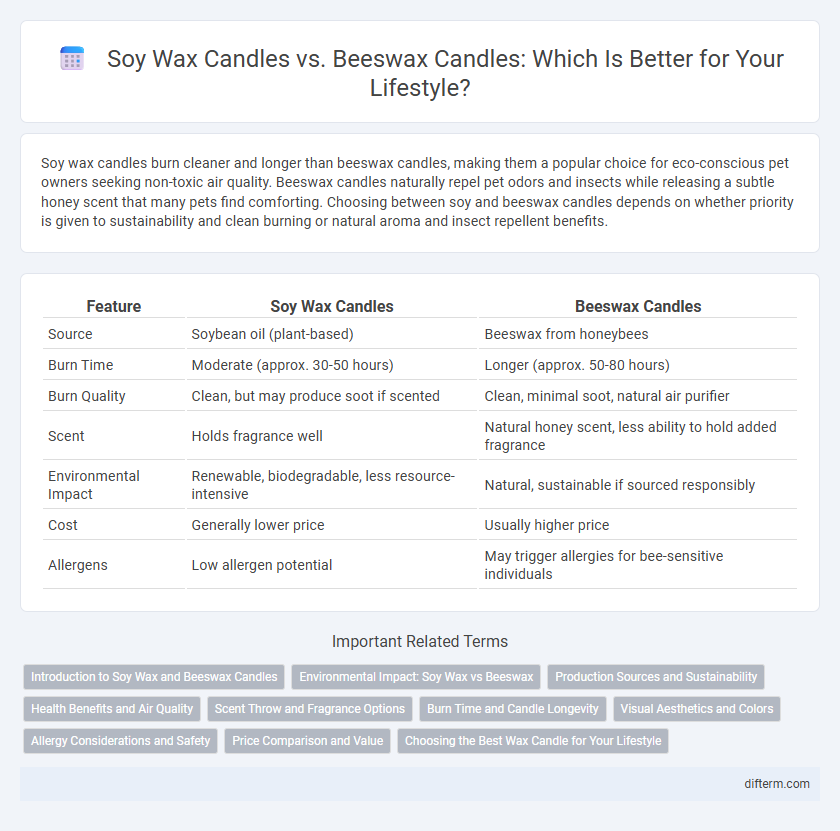Soy wax candles burn cleaner and longer than beeswax candles, making them a popular choice for eco-conscious pet owners seeking non-toxic air quality. Beeswax candles naturally repel pet odors and insects while releasing a subtle honey scent that many pets find comforting. Choosing between soy and beeswax candles depends on whether priority is given to sustainability and clean burning or natural aroma and insect repellent benefits.
Table of Comparison
| Feature | Soy Wax Candles | Beeswax Candles |
|---|---|---|
| Source | Soybean oil (plant-based) | Beeswax from honeybees |
| Burn Time | Moderate (approx. 30-50 hours) | Longer (approx. 50-80 hours) |
| Burn Quality | Clean, but may produce soot if scented | Clean, minimal soot, natural air purifier |
| Scent | Holds fragrance well | Natural honey scent, less ability to hold added fragrance |
| Environmental Impact | Renewable, biodegradable, less resource-intensive | Natural, sustainable if sourced responsibly |
| Cost | Generally lower price | Usually higher price |
| Allergens | Low allergen potential | May trigger allergies for bee-sensitive individuals |
Introduction to Soy Wax and Beeswax Candles
Soy wax candles are made from hydrogenated soybean oil, providing a renewable and biodegradable alternative to traditional paraffin candles with a clean burn and longer lasting scent. Beeswax candles, produced naturally by honeybees, offer a non-toxic, hypoallergenic option that emits a subtle honey aroma while purifying indoor air by releasing negative ions. Both soy and beeswax candles enhance ambiance and sustainability, appealing to eco-conscious consumers seeking healthier, environmentally friendly home lighting solutions.
Environmental Impact: Soy Wax vs Beeswax
Soy wax candles are derived from soybean oil, making them biodegradable and renewable with a lower carbon footprint compared to paraffin candles, yet their cultivation can contribute to deforestation and pesticide use. Beeswax candles are natural and sustainable, produced by honeybees, offering air-purifying properties and longer burn times, but their environmental impact depends on ethical beekeeping practices and bee population health. Choosing between soy and beeswax candles involves balancing renewable sourcing and ecological effects, with both options preferable to petroleum-based alternatives in minimizing environmental harm.
Production Sources and Sustainability
Soy wax candles are derived from soybean oil, a renewable and biodegradable resource primarily sourced from sustainable farms, making them an eco-friendly choice with a lower carbon footprint. Beeswax candles come from honeybee hives, supporting natural pollination and biodiversity but raising concerns about bee population health and ethical sourcing. Both options emphasize sustainability, though soy wax production often involves larger-scale agriculture, while beeswax relies on responsible beekeeping practices to maintain ecological balance.
Health Benefits and Air Quality
Soy wax candles emit fewer toxins and pollutants compared to traditional paraffin, improving indoor air quality and reducing respiratory irritation. Beeswax candles release negative ions that neutralize airborne allergens, dust, and pollutants, promoting cleaner air and potential allergy relief. Both options provide healthier alternatives to conventional candles, with beeswax offering inherent antimicrobial properties and soy wax supporting a cleaner burn with less soot.
Scent Throw and Fragrance Options
Soy wax candles offer a strong scent throw and a wide variety of fragrance options, as they easily absorb and release essential oils and synthetic fragrances. Beeswax candles emit a natural, subtle honey-like aroma with a moderate scent throw, appealing to those who prefer a more organic fragrance experience. The choice between soy and beeswax candles depends on whether a robust, customizable scent or a gentle, natural fragrance is desired for home ambiance.
Burn Time and Candle Longevity
Soy wax candles typically offer a longer burn time compared to beeswax candles due to their lower melting point, allowing a slower and more consistent burn. Beeswax candles, while generally more expensive, burn hotter and brighter, resulting in a shorter overall burn time but enhanced longevity in terms of scent retention and natural air purification benefits. Choosing between soy and beeswax candles depends on whether you prioritize extended burn duration or the natural qualities and ambiance provided by beeswax.
Visual Aesthetics and Colors
Soy wax candles offer a smooth, creamy texture with a natural off-white color that enhances minimalist and modern decor styles. Beeswax candles tend to have a rich, golden hue with subtle variations, adding warmth and a rustic, vintage charm to any setting. Both types provide visually appealing aesthetics, but soy wax candles allow for a broader palette of dye colors due to their lighter base.
Allergy Considerations and Safety
Soy wax candles are often preferred for allergy-sensitive individuals due to their natural, non-toxic composition and low soot production, reducing respiratory irritation. Beeswax candles emit negative ions that can purify the air, but they may trigger allergic reactions in those sensitive to bee products or pollen residues. Both types require proper ventilation to ensure safety, but soy wax candles generally present a lower allergen risk in enclosed environments.
Price Comparison and Value
Soy wax candles typically cost less than beeswax candles, making them a budget-friendly option for consumers. While beeswax candles have a higher price point, their longer burn time and natural air-purifying properties offer superior value. Evaluating overall cost-effectiveness, beeswax candles provide durable quality despite the initial higher investment.
Choosing the Best Wax Candle for Your Lifestyle
Soy wax candles offer a clean, eco-friendly burn with longer-lasting fragrance, making them ideal for those seeking sustainable and allergen-free home ambiance. Beeswax candles provide natural air purification and a subtle honey scent, perfect for individuals prioritizing non-toxic, chemical-free environments. Selecting between soy and beeswax depends on lifestyle preferences such as allergy sensitivity, desire for organic materials, and commitment to environmental impact.
Soy Wax Candles vs Beeswax Candles Infographic

 difterm.com
difterm.com